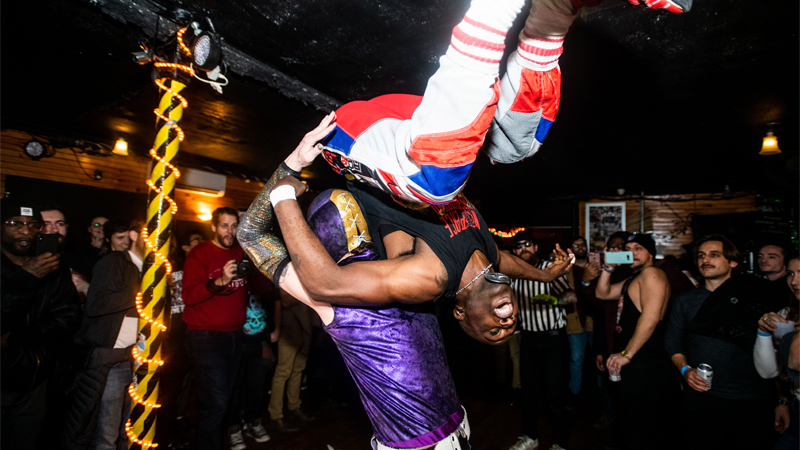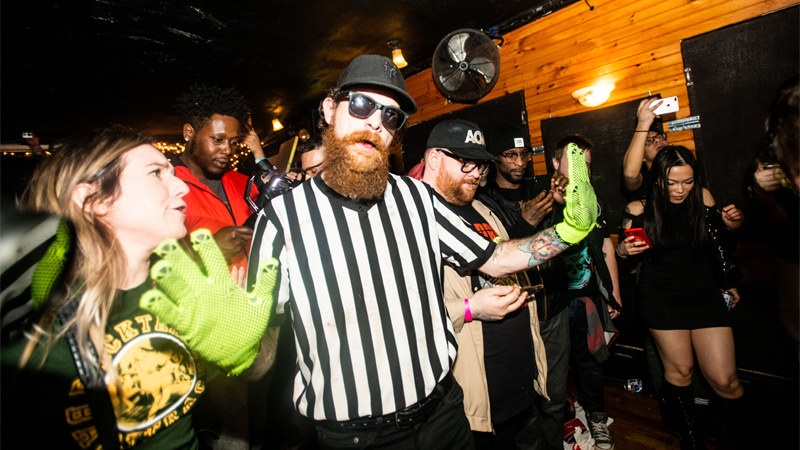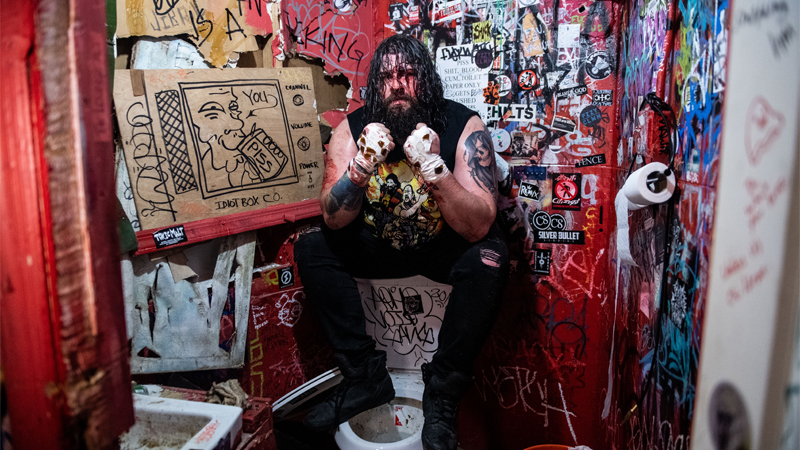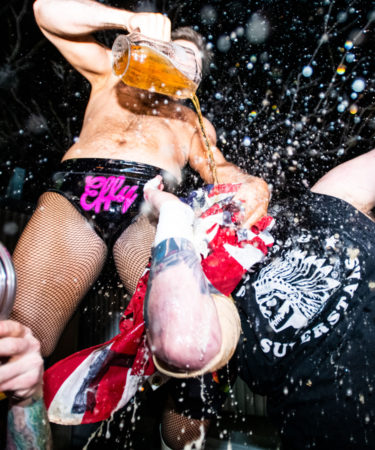Punk rockers have always had an affinity for pro wrestling, maybe because of the storylines: Stone Cold Steve Austin sticking it to billionaire World Wrestling Entertainment (WWE) CEO Vince McMahon in a vicious rejection of oligarchical power (even if it was — and, it was — all part of a script). It could be that pro-wrestling’s spectacular violence is just plain fun, and a good excuse to drink.
But if regular pro wrestling is punk rock, then deathmatch wrestling is harsh noise. With a general disdain for human decency, and stripped of televised wrestling’s aesthetic concerns, deathmatch wrestling has recently seen unexpected resurgence in the United States — or at least, it had. Considering the devastation that Covid-19 brought to the indie wrestling world (and entertainment landscape writ large), fans are left wondering if deathmatch wrestling will ever return to punk bars across the U.S. and abroad.
Within the last decade, the emergent deathmatch wrestling scene has ditched the formalities (and legalities) of the professional wrestling industry by teaming up with local bars and holding full-fledged fights amidst the booze. Dropping the framing mechanisms of actual wrestling —the ring, the bell, the fabricated rules — these bar brawls and DIY deathmatches have found enthusiastic audiences looking for grittier experiences and more ferocious stories than what’s usually seen on TV.
LuFisto, one of the first female deathmatch pro wrestlers in the history of the sport, defined deathmatch pro-wrestling to me in March of 2019 as “a match where disqualifications, count-outs, and all other rules do not apply. … The only rule is that you need to pin or submit your opponent to win. There can also be a victory via KO or referee stoppage. The use of weapons is a must, and you will definitely see blood and several cuts. The bloodier, the better.”
Like in more above-ground pro wrestling, the outcome of a deathmatch is usually determined beforehand, as are some sequences of moves and stunts, or “spots,” in each match. Beyond that, the bloodthirsty wantonness of the fighters is largely unchecked, and the creativity of the brawls borders on the magically real. Any and all objects — bladed weapons, neon light tubes, kitchen appliances, barbed wire, broken beer bottles, dildos — are suddenly transformed into apparatuses of pain. However, as in more “legitimate” wrestling, deathmatch wrestlers still go out of their way to avoid “real” injuries, despite their sanguine proclivities.
‘Everybody Dies!’: Inclusivity in The Deathmatch Scene
It’s easy to assume that the participants in this bloodsport are mostly grisly, hyper-macho, white men with anger problems. This is simply far from the case. Having worked within the scene for a few years as a DJ and organizer, the feature of deathmatch wrestling that continues to surprise me the most is, ironically, its unending kindness. Despite or perhaps because of the inherent ultra-violence of the medium, deathmatch wrestlers are extremely attuned to the needs of their colleagues and audiences, and the crowds — many of whom are not even really casual wrestling fans — return the magnanimity with unbridled enthusiasm. The athletes invariably display unexpected sweetness the second the match ends.
“We get to smash each other but afterwards we buy each other a beer,” says Casanova Valentine, a Brooklyn-based pro wrestler widely credited for reinvigorating the indie deathmatch scene. We get our animalistic urges out but we’re still friends, and we still protect each other, and we’re having fun in a way that no one is actually getting hurt.”
With this in mind, it makes sense that deathmatch wrestling is often paired with a true commitment to inclusivity. While TV pro wrestling still has serious problems with regard to diverse representation, deathmatches tend to feature a colorful cast of characters from a plethora of backgrounds, along with exciting collaborations with other art forms also commonly perceived as lowbrow. The events that Valentine is often booked on have recently featured drag performances, fashion shows, noise art, queer DJs, sludge metal bands, and more — alongside a diverse roster of male, female, and non-binary brawlers. Everyone is encouraged to fight to the death.

This was something Valentine had consciously considered while creating his brand: “I guess a lot of people probably think [deathmatch wrestling] is like some white supremacist rally in a basement — but even though it’s the most violent thing in the world, I want it to be a safe space,” Valentine says, yelling, “like, can’t we all just have fun together?! I mean, f*ck!”
Not everyone is behind deathmatch wrestling. Older industry stalwarts who desperately fought to protect what’s known in the business as kayfabe — that is, the illusion of reality perpetuated by the wrestling industry — have repeatedly denounced deathmatch wrestling as a potentially industry-killing de-evolution of the sport. These staunch critics see deathmatch wrestling as the end of wrestling’s integrity, with the glory and glamour of yesteryear reduced to drunken bar fights. They also see deathmatch wrestling as a potentially injurious art form, considering the potentially life-threatening nature of these fights.
“Twenty years ago, we PRETENDED to hurt each other, and the fans believed it,” writes Jim Cornette, a former WWF personality and decision maker-turned-divisive critic. “Today, we REALLY DO hurt each other, and the fans think it’s fake. Who are the marks now?” (World Wrestling Federation, or WWF, was a precursor to what is now WWE.)
“Deathmatch wrestling is fairly liberal,” says Bam Sullivan, a New York-based pro wrestler. “It’s a new, progressive, exciting thing. It turns away the more conservative, elitist mentalities.”
“But I get where they’re coming from,” Sullivan continued. “They feel very protective. It all comes from our love of pro wrestling and they don’t want to see what they love so much become, in their view, desecrated. But if something’s making money and everyone’s happy then, I’m sorry, but just shut the f*ck up.”
Valentine disagrees: “The old-school wrestling people say it’s just violence for the sake of violence; they say there’s no craft or storytelling,” he says. “Personally, I think wrestling is a big enough spectrum that there’s something in wrestling for everyone, whether it’s comedy, or violence, or technical skill. I consider wrestling art, and that means it can be whatever I want it to be. There’s Jackson Pollock and there’s photorealism, you know?”
“Deathmatch wrestling shows how we all crave the element of danger, that thrill,” says Sullivan. “There’s some kind of car crash-eque appeal in deathmatch wrestling. … In the age of the Internet we get so bored and so jaded so easily by what we’re constantly looking at. It’s counter-cultural, the complete antithesis of what so many people had been watching on TV for so long.”
For Valentine, “It’s the lawlessness — I like the idea of escapism. For a moment, you’re not hearing about the news or the bullsh*t of politics. I guess it’s just taking a break from society and all its bullshit rules for 15 minutes. When you’re at the show, there’s no bullshit. There’s something very primitive and beautiful about watching two people fight. I don’t know why, it’s so therapeutic. ”
Deathmatch Wrestling: From Promising Beginnings to an Uncertain Future

Valentine began throwing a series of events in Brooklyn’s Williamsburg in 2016, catalyzing a reinvention of the deathmatch scene as it was known. He used the phrase “No Ring, No Rules,” which he would later go on to trademark. The first endeavor was actually framed as an art show titled “Deathmatch: A Tribute to Pro-Wrestling Tragedy,” and the exhibition included Valentine’s painted portraits of famous dead wrestlers, video compilations of real-life wrestling injuries, and a bar fight presented as a performance piece.
“It just ended up taking off! I started running at punk rock bars that I already had relationships with from working as a bouncer and being in nightlife,” Valentine says. “There was no overhead other than the weapons. … It’s more of a fun party with my talented buddies than a soulless cash grab.”
The reason he chose bars as his venues was simple: “The idea of doing them in bars was to bring wrestling to people where they already are,” says Valentine. “Doing these shows in brightly lit middle schools … it’s just not cool. And I wanted to make independent wrestling cool.”
What began as a handful of small-scale parties featuring live bands and bloody battles in dive bars became a widespread movement. Valentine has since helped to establish No Peace Underground, a small-scale deathmatch company in Orlando, Fla. Founders Ryan Fox and Jared Tawasha, two employees at a struggling venue called Back Booth (since renamed Soundbar) organized the brand’s first event in late 2017 as a last-ditch effort to save their jobs before the bar went out of business. Their first show was financially successful enough to keep the place afloat. The company has since evolved into a full-fledged deathmatch federation that has put on around 20 highly produced, scripted shows in three years.
“I had discussed the idea with some promoters about doing a wrestling show, but the owner wasn’t cool with it,” says Tawasha. “Fast-forward to a few months later: We’re coming up on Halloween and the owner is scrambling, so he says, ‘I don’t care what you do!’ Lo and behold, around 80 people showed up on a Monday night!”
Fox, his co-founder, adds: “It was Devil’s Night, I remember … the last night on the calendar to keep the bar open.”
Meanwhile, in North Dakota, Time Bomb Pro founder Eric Morrison was hatching a plan of his own. He held his first deathmatch show in October 2018. “I had been booking [hardcore punk shows] for quite a while,” Morrison recalls. “It was pretty easy to transfer that over to wrestling. It’s basically the same thing, just a slightly different product. It’s just out of control at this point. I never really expected it to move on past a couple [of] shows.”
Morrison’s most adventurous event, which went viral on wrestling Twitter, was called the Twink Gauntlet, in which openly gay fighter Effy battled an ornery mob of skinny boys until he was beaten by — wait for it — a bear mascot.
“My biggest struggle is finding places that are OK to host these kinds of events. It’s hard for me to tell people upfront, ‘People are going to be bleeding all over your bar,’ Morrison says. “The wrestling culture in North Dakota is basically non-existent. There’s maybe three independent promotions and it’s very family friendly, PG shows. So what I’m doing is really different.”

As businesses closed in March and country-wide lockdowns began, the indie wrestling world saw sweeping cancellations of almost all events, causing widespread devastation in the industry and leaving slews of performers without work. Although many parts of the U.S. remain in various stages of shutdown and reopening, we’re just now beginning to see the glimmers of a potential wrestling re-emergence. The speed at which events can restart remains a question, as concerns over a second wave of Covid remain very real — and the rules about how many people can be in certain places seem to be changing by the second.
In areas beginning the process of reopening, indie wrestling is starting to adapt, with first signs including drive-in wrestling events and low-capacity or empty arena events, which will later be streamed online. But the risks of wrestling itself are, of course, still there — forcing performers to get creative about the settings in which these productions can take place without causing harm.
At the moment, Morrison is scouting locations for outdoor deathmatch shows to be held in fall of 2020, although he’s keeping a close eye on how risky that might be. “If it doesn’t feel safe I won’t do it,” he says definitively. “Bars are reopening in North Dakota at 75 percent capacity, but I’m not exactly sure about the event regulations yet.”
Soundbar is currently listed as open, but amid recent reports of a spike in coronavirus cases in Florida, that status could change in a moment’s notice. Tawasha and Fox did not respond to requests for comments about the future of No Peace Underground.
Throughout the reporting of this piece, Valentine was on an international tour, producing and performing at deathmatch events in Australia and the United Kingdom. He had hoped to bring his brand of chaos into bars across the globe, but watched his matches and shows get cancelled, one by one — nearly 30 scheduled events were obliterated and plans to reschedule them remain unclear.
“For my No-Ring bar shows, I’m hoping to do them when it’s safe to do so,” Valentine says, adding that his goals include doing more shows in outdoor settings, having limited capacities, and “having everyone wear masks.” But, he adds, “my shows, they’re punk rock, so they still won’t be sanctioned.”
“Eventually, wrestling will be back to the way it was, but it’s going to be slow,” he adds. “It’s uncertain. We don’t really know. The fact of the matter is that in wrestling, you’re bleeding and sweating on someone, and it’s a major risk. This is all I’ve ever wanted to do my whole life, but I also want to have a life.”
